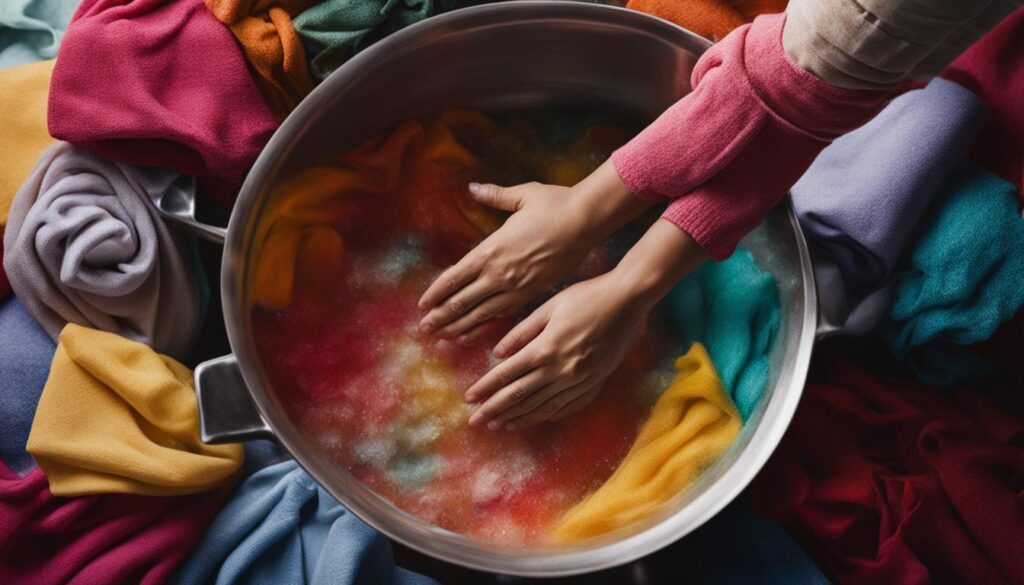If you usually wash your clothes at a laundromat, you may be surprised to learn that it is possible to effectively hand wash your clothing at home. With a few expert tips, you can achieve clean and fresh results that rival professional washing.
When it comes to hand washing, laundry expert Patric Richardson recommends starting with a clean kitchen sink. Ensure it is fully cleaned to provide enough space to wash multiple pieces at once. This eliminates the need to make multiple trips to the laundromat, saving you time and money.
Instead of using traditional laundry detergent, opt for warm water and gentle hand soap or shampoo. This alternative cleanses your clothes effectively without harsh chemicals. Leave your clothes in the soapy water for about 20 minutes, gently manipulating them every few minutes to ensure an even clean.
After the soaking period, drain the soapy water and fill the sink with cool water for rinsing. Swish the clothes gently in the clean water to remove any remaining soap. Once the clothes are thoroughly rinsed, give them one final swish in clear water before they are ready to dry.
Key Takeaways:
- Hand washing clothes at home is an effective alternative to using a laundromat.
- Clean your kitchen sink thoroughly before starting the hand washing process.
- Use gentle hand soap or shampoo instead of regular laundry detergent.
- Manipulate the clothes every few minutes while they soak in the soapy water.
- Rinse the clothes in cool water to remove any remaining soap before drying.
The Benefits of Hand Washing Clothes
Hand washing clothes at home can provide numerous benefits that make it a compelling option. Whether you’re doing it at home or using a self-service laundry, opting for hand washing offers advantages that ensure clean clothes while also being good for your wallet and the environment.
Control Over the Washing Process
When you hand wash your clothes, you have complete control over the entire washing process. You can carefully choose the temperature, type of detergent, and duration of the wash, ensuring that your clothes are treated gently and according to their specific needs.
Cost-Effective Solution
In addition to the control it provides, hand washing is also a cost-effective option. Using a laundromat or professional laundry services can be expensive, especially when you factor in the cost of the machines and detergents. By hand washing your clothes, you eliminate the need to pay for coin-operated machines or laundry services, saving you money in the long run.
Sustainability and Reduced Environmental Impact
Hand washing clothes is a more sustainable choice compared to using washing machines. By hand washing, you reduce water consumption as you only use what is necessary to clean your clothes. Additionally, hand washing eliminates the need for electricity, reducing your energy consumption and environmental impact.
By choosing to hand wash your clothes, you not only have control over the washing process but also contribute to a more sustainable lifestyle. Hand washing allows you to maintain the quality of your clothes, save money, and reduce your environmental footprint. It’s a win-win situation for both you and the planet.
Expert Tip:
“Hand washing clothes not only ensures a thorough clean but also provides the opportunity to care for delicate fabrics and preserve their longevity. It’s a method that puts you in charge and allows you to handle your laundry with care.”
Choosing the Right Detergent for Hand Washing
When it comes to hand washing your clothes, selecting the right detergent is crucial. We recommend using gentle hand soap or shampoo instead of traditional laundry detergent. These options are effective in keeping your garments fresh and clean, while also being easier to rinse out. Unlike dish soap, which can be harsh on fabrics and challenging to remove, gentle hand soap and shampoo are specifically formulated for use on the skin and hair.
By opting for gentle hand soap or shampoo, you can ensure that your clothes receive the care they deserve during the hand washing process. These alternatives are designed to remove dirt and stains while being gentle on fabrics, preventing any damage or discoloration.
If you have a preferred laundry soap that you trust for machine washing, it can also be used for hand washing. Just remember to follow the instructions on the packaging and use the appropriate amount for the water volume and load size.
Choosing the right detergent is an essential step towards achieving optimal results when hand washing your clothes. It ensures that your garments are effectively cleaned, smelling fresh, and ready to be enjoyed once again.
Hand washing your clothes is a simple and effective way to ensure their cleanliness and longevity. By using gentle hand soap or shampoo, you can take care of your garments while getting them properly clean. Don’t forget to read on for more valuable tips and techniques for successful hand washing.
Proper Technique for Hand Washing Clothes
When it comes to hand washing your clothes, following the proper technique ensures effective cleaning while preserving the integrity of your garments. Here’s a step-by-step guide to help you achieve the best results:
- Prepare the sink: Start by cleaning out your sink and ensuring it’s free of any debris or residue. This provides a clean space for washing your clothes.
- Fill the sink: Fill the sink with warm water, ensuring it’s at a comfortable temperature for your hands.
- Add detergent: Choose a gentle detergent suitable for hand washing, and mix it into the water until it’s well-dissolved.
- Immerse the clothes: Place your clothes into the soapy water, ensuring they’re fully submerged.
- Agitate gently: Gently agitate the clothes in the water, ensuring that each garment is evenly exposed to the detergent. Avoid being too rough, as this can damage the fabric.
- Soak for 20 minutes: Let the clothes soak in the soapy water for about 20 minutes. This allows the detergent to penetrate the fabric and loosen any dirt or stains.
- Drain and rinse: After the soaking period, drain the soapy water from the sink.
- Final rinse: Fill the sink with cool water for the final rinse. Gently swish the clothes in the clean water to remove any remaining soap.
- Squeeze out excess water: Once rinsed, gently squeeze out excess water from the clothes. Avoid twisting or wringing them, as this can stretch or damage the fabric.
- Dry the clothes: Hang or lay out the clothes to dry, ensuring they’re placed in a well-ventilated area away from direct sunlight.
By following this technique, you can effectively hand wash your clothes at home without the need for a laundromat or washing machine. It’s a convenient and eco-friendly way to keep your garments clean and well-maintained.
Sanitizing Your Hand-Washed Clothes
When it comes to hand washing your clothes, it’s not just about getting them clean. It’s also essential to ensure that they are free from germs and bacteria. Hand washing with soap is an effective way to remove these unwanted contaminants. The lipids in soap attach to bacteria and viruses, lifting them from the fabric as you wash. This process helps to keep your clothes clean and fresh, promoting better hygiene.
However, if you want to take sanitization a step further, there are additional methods you can consider. One option is to steam your hand-washed clothes. Steamers can reach temperatures of 200 degrees or more, effectively killing flu viruses and other germs. Steaming your garments can provide an extra layer of cleanliness and help ensure that they are germ-free.
“The combination of hand washing and steaming is an excellent method to not only clean your clothes but also eliminate any remaining germs. This extra step can be particularly beneficial during times when hygiene is a top priority,” says laundry expert Patric Richardson.
If you don’t have a steamer, another option is to use an iron. Ironing your hand-washed clothes can also help kill germs and bacteria. Most irons reach temperatures of at least 167 degrees, which is sufficient to eliminate flu viruses. Remember to follow the proper ironing instructions for each garment to prevent any damage.
Pros and Cons of Sanitizing Hand-Washed Clothes
| Pros | Cons |
|---|---|
| Provides an extra layer of cleanliness | Requires additional time and effort |
| Helps eliminate lingering germs and bacteria | Not necessary for all types of clothing |
| Can be done with a steamer or an iron | Additional equipment may be required |
Whether you choose to steam or iron your hand-washed clothes, it’s important to be cautious and follow safety guidelines. Handle hot appliances carefully to avoid burns or accidents. Remember, while sanitizing your clothes is beneficial, it’s also essential to maintain proper hand hygiene by washing your hands thoroughly before and after handling your garments.
Next, we will explore how often to wash and sanitize your clothes, taking into consideration various factors such as exposure to germs and dirt.
How Often to Wash and Sanitize Clothes
The frequency of washing and sanitizing your clothes depends on their level of exposure to germs and dirt. At our laundromat, we recommend following these guidelines to keep your clothes clean and fresh.
Wear Until Dirty: Unless your clothes have been exposed to outside germs, it is generally sufficient to wear them until they are truly dirty before washing. This approach not only saves time and energy but also extends the lifespan of your garments.
Sanitize After Exposure: If you have been in public places or around sick individuals, it is crucial to wash and sanitize your clothes immediately upon returning home. This helps to eliminate any potential germs or bacteria that may have attached to your clothing.
Richardson suggests wearing your clothes until they are truly dirty or have been exposed to outside germs.
To maintain hygiene and cleanliness, follow these general guidelines:
Frequency:
- Clothes that have not been exposed to outside germs can go without sanitizing for 6 to 7 wearings.
- After being in public or around sick individuals, wash and sanitize your clothes immediately upon returning home.
Extra Tips:
- Washing clothes in warm water and using detergent helps eliminate germs and bacteria.
- If you’re unsure whether your clothes require immediate sanitization, always err on the side of caution and wash them.
By following these guidelines, you can ensure that your clothes remain clean, fresh, and free from harmful germs. Stay proactive in maintaining hygiene and confidence in your wardrobe with our laundromat services.
| Frequency | Recommendation |
|---|---|
| Clothes not exposed to outside germs | 6 to 7 wearings without sanitizing |
| After exposure to public places or sick individuals | Wash and sanitize immediately upon returning home |
Air-Drying Techniques for Hand-Washed Clothes
After hand washing your clothes, it is important to air dry them properly to ensure they retain their cleanliness and quality. Here are some effective air-drying techniques for your hand-washed clothes:
- Invest in a large, foldable drying rack: A drying rack provides ample space for hanging multiple garments and allows for better air circulation, speeding up the drying process. Place the rack in a well-ventilated area to aid in the evaporation of moisture.
- Utilize open-air surfaces: If you don’t have a drying rack, you can lay your clothes over open-air surfaces such as the backs of chairs or curtain rods. This method works well for lightweight garments and smaller loads.
- Consider a salad spinner for small items: For individually hand-washed items or smaller loads, a salad spinner can mimic the spin-dry action of a laundry machine. Use the spinner to remove excess water before air drying. Be sure to clean the salad spinner thoroughly before using it for food again.
- Speed up drying with a dehumidifier: If your hand-washed clothes are taking longer than usual to dry, consider using a dehumidifier in the drying area. A dehumidifier helps to reduce moisture in the air, effectively speeding up the drying process.
By following these air-drying techniques, you can ensure that your hand-washed clothes dry efficiently and maintain their cleanliness. Proper air drying helps to prevent shrinkage, maintain garment shape, and keep your clothes looking their best.
Hand-Washing Delicate Clothing
Delicate clothing items require special care to preserve their shape, color, and overall appearance. When it comes to lingerie, cashmere sweaters, and other delicate fabrics, hand washing is the best method to ensure longevity.
Before you begin, always read the care label of each delicate item to understand any specific instructions or restrictions. This will guide you in selecting the appropriate cleaning techniques and detergents.
To hand wash delicate clothing:
- Fill a sink or tub with lukewarm water.
- Add a mild liquid detergent suitable for delicate fabrics.
- Gently immerse the garments in the soapy water.
- Swish the items around gently, paying careful attention not to stretch or wring them.
- Allow the garments to soak for a few minutes to let the detergent penetrate the fibers.
- After soaking, rinse thoroughly with clean water to remove all traces of detergent.
- Do not twist or wring the clothing while rinsing to avoid damaging the delicate fabric.
- Press the garments gently against the side of the sink or tub to remove excess water.
- Lay the garments flat on a clean towel or a drying rack, reshaping them as necessary.
- If desired, use padded hangers to dry delicate items that need to maintain their shape.
- Avoid hanging delicate fabrics, as this may cause them to stretch or lose their shape.
It’s important to note that delicate fabrics made from synthetic fibers, such as lace or chiffon, also require gentle treatment. Follow the same hand-washing process outlined above, paying close attention to the specific care instructions provided by the manufacturer.
By hand washing your delicate clothing, you can ensure its longevity and keep it looking its best. The gentle cleaning process and proper drying technique will help preserve the shape, color, and overall quality of your favorite lingerie and cashmere sweaters.
Comparison of Hand-Washing and Machine-Washing Delicate Clothing
| Hand-Washing | Machine-Washing | |
|---|---|---|
| Cleaning Effectiveness | Gentle cleaning that preserves delicate fabrics | Vigorous agitation can cause damage to delicate items |
| Control | You have complete control over the washing process and can ensure gentle treatment | You rely on the settings and performance of the washing machine, which may not be suitable for delicate items |
| Drying | Drying flat or using padded hangers helps maintain the shape of delicate clothing | Tumbling in a dryer can cause items to shrink, stretch, or wrinkle |
| Care Instructions | You can follow the specific care instructions provided by the manufacturer | You may need to guess or rely on general settings that may not be suitable for delicate fabrics |
| Detergent | You can use a mild liquid detergent specifically formulated for delicate fabrics | You need to select a suitable detergent, but it may not provide the same level of gentleness |
Note: Hand-washing is strongly recommended for delicate clothing to ensure proper care and maintenance. Always follow the care instructions provided by the manufacturer for the best results.
Tips for Hand-Washing Bras and Lingerie
When it comes to caring for your delicate bras and lingerie, hand-washing is essential to maintain their shape and ensure longevity. Follow these tips to keep your favorite intimate garments looking their best:
Gather Your Supplies
Before you begin, make sure you have the necessary supplies:
- A clean sink
- Lukewarm water
- A gentle detergent
The Hand-Washing Process
- Fill the sink with lukewarm water and add a small amount of gentle detergent. Avoid using harsh or abrasive products that can damage delicate fabrics.
- Place your bras and lingerie in the soapy water and let them soak for about 15 minutes. This will help to loosen any dirt or oils on the fabric.
- Gently work the suds into the fabric, paying extra attention to any stained or soiled areas. Use your fingers to lightly agitate the garments without twisting or stretching them.
- Rinse thoroughly with cool water to remove all traces of detergent. Make sure to squeeze the fabrics gently to release any excess water.
- Reshape the bras by gently smoothing out any wrinkles or folds. Avoid wringing or twisting the garments, as this can damage the delicate fibers.
- Lay the bras and lingerie flat on a clean, dry towel to remove additional moisture. Avoid hanging them, as this can cause them to lose their shape.
- Allow the garments to air dry completely before storing or wearing them.
By following these hand-washing tips, you can keep your bras and lingerie in great condition, helping them to last longer and maintain their beautiful appearance.
| Benefits of Hand-Washing Bras and Lingerie | Benefits |
|---|---|
| Gentle on fabrics | Hand-washing minimizes the risk of stretching or damaging delicate fabrics. |
| Preserves shape | Hand-washing helps maintain the shape and support of bras, ensuring a comfortable fit over time. |
| Improves longevity | Delicate lingerie can last longer when hand-washed, reducing the need for frequent replacement. |
| Protects embellishments | Hand-washing minimizes the risk of embellishments, such as lace or sequins, becoming detached or damaged. |
Hand-washing bras and lingerie is a simple yet important step in caring for your delicate garments. By investing a little extra time and care, you can enjoy the luxury and beauty of your intimates for years to come.
Hand-Washing Underwear
When it comes to keeping your underwear clean and fresh, hand-washing is essential. Follow these simple steps to ensure your underwear stays in great condition:
- Fill a sink with warm water.
- Add a gentle detergent suitable for delicates.
- Place your underwear in the soapy water and let it soak for up to 30 minutes, swishing it periodically to ensure thorough cleaning.
- Rinse the underwear with lukewarm water until the soap is completely removed.
- Gently squeeze out excess water without wringing or twisting the fabric.
- Reshape the underwear to its original form.
- Lay the underwear flat to dry, away from direct heat or sunlight.
Remember, hand-washing your underwear not only helps maintain its cleanliness but also extends its lifespan. Keep your undergarments in great shape and enjoy the comfort they provide.
| Benefits of Hand-Washing Underwear | Benefits of Machine Washing Underwear |
|---|---|
| Avoids stretching or damage caused by machine agitation | Convenient and time-saving |
| Gentle on delicate fabrics and embellishments | Can handle larger loads |
| Reduces the risk of color fading | Faster drying time |
| Lessens exposure to harsh detergents and chemicals | Deep cleans heavily soiled underwear |
Hand-Washing Sweaters
When it comes to caring for your sweaters, hand-washing can be a safe and effective alternative to dry cleaning. By following a few simple steps, you can ensure that your sweaters remain clean and well-maintained. Here are some tips for hand-washing sweaters:
- Check the care tag: Before hand-washing your sweaters, always check the care instructions on the tag. This will provide specific guidelines for the best washing method.
- Prepare the sink: Fill a clean sink with lukewarm water. Avoid using hot water as it can cause the fibers to shrink or lose their shape. Add a small amount of gentle detergent specifically designed for delicate fabrics.
- Spot treat stains: If there are any stains on the sweater, use a mild stain remover or detergent to treat them before immersing the garment in water.
- Hand wash gently: Immerse the sweater in the soapy water and gently agitate the water with your hands. Avoid rubbing or wringing the sweater, as this can damage the fibers.
- Rinse thoroughly: Drain the soapy water and refill the sink with clean lukewarm water. Gently swish the sweater in the water to remove any remaining soap.
- Squeeze out excess water: Carefully lift the sweater out of the water and gently squeeze out the excess water. Do not twist or wring the sweater, as this can cause it to lose its shape.
- Dry flat: Lay a clean, dry towel on a flat surface and place the sweater on top. Gently reshape the sweater to its original form. Leave it to air dry completely.
- Flip and repeat: Once the front of the sweater is dry, flip it over and lay it on a clean, dry towel to continue drying the back. This ensures that both sides of the sweater dry evenly.
By following these guidelines, you can hand-wash your sweaters with confidence, knowing that they will come out clean and well-maintained. Hand-washing not only helps to prolong the life of your sweaters but also allows you to avoid the harsh chemicals used in dry cleaning.
Quote:
“Hand-washing sweaters is a simple and effective way to care for your favorite knitwear. By following the proper steps, you can maintain the quality and appearance of your sweaters for years to come.” – Patric Richardson
To illustrate the process of hand-washing sweaters, here is a step-by-step table:
| Step | Instructions |
|---|---|
| 1 | Check the care tag for specific washing instructions. |
| 2 | Fill a clean sink with lukewarm water and add a gentle detergent. |
| 3 | Spot treat any stains with a mild detergent or stain remover. |
| 4 | Submerge the sweater in the water and gently agitate it. |
| 5 | Rinse the sweater with clean lukewarm water. |
| 6 | Gently squeeze out excess water. |
| 7 | Lay the sweater flat on a towel to dry. |
| 8 | Flip the sweater over to dry the other side. |
Hand-washing your sweaters is a simple yet effective way to keep them clean, fresh, and in great condition. Follow these steps and enjoy the longevity of your favorite knitwear.
The Ultimate Hand-Washing Tool Kit
To make hand washing clothes easier, it’s helpful to have a few essential tools on hand. Consider using a gentle liquid detergent specifically designed for delicates, such as Woolite Delicates or Tide Free & Gentle. A laundry stain remover like Shout Advanced Action Gel is also useful for treating stains before washing. Additionally, a collapsible colander can make rinsing lightweight garments more convenient.
Conclusion
Hand washing clothes can be a practical and effective option, whether you’re doing it at home or in a laundromat. By following the proper techniques and using the right detergents, you can ensure that your clothes remain fresh and clean. Hand washing offers a range of benefits, including increased control over the washing process and cost-effectiveness compared to using laundromat services.
When hand washing, it’s important to take care of delicate items separately and air dry them properly to maintain their quality. For larger loads, investing in laundromat equipment or using self-service laundry facilities can make the process more efficient.
With these expert tips, you can maximize your laundry experience and keep your clothes looking their best. Whether you’re hand washing at home or utilizing laundromat services, you now have the knowledge to tackle your laundry needs with confidence.
FAQ
Can I effectively hand wash my clothes at home if I usually wash them at a laundromat?
Yes, it is possible to effectively hand wash your clothing at home. You can use your kitchen sink as a washing space and gentle hand soap or shampoo instead of laundry detergent.
What are the benefits of hand washing clothes?
Hand washing clothes allows you to have control over the washing process, ensures gentle treatment of your clothes, is cost-effective compared to using coin-operated machines at a laundromat, and is a more sustainable choice as it reduces water and energy consumption.
What detergent should I use for hand washing clothes?
It is recommended to use gentle hand soap or shampoo instead of traditional laundry detergent. Avoid using dish soap, as it can be harsh on fabrics.
What is the proper technique for hand washing clothes?
Start by immersing the clothes in warm water mixed with your chosen detergent, then let them soak for about 20 minutes, gently agitating them every few minutes. After soaking, drain the soapy water and fill the sink with cool water for the final rinse. Gently swish the clothes in the clean water to remove any remaining soap.
How can I sanitize my hand-washed clothes?
Hand washing clothes with soap effectively removes germs and bacteria. To further sanitize your hand-washed clothes, you can steam or iron them, as heat of 167 degrees or more is sufficient to kill flu viruses.
How often should I wash and sanitize my clothes?
The frequency of washing and sanitizing your clothes depends on the level of exposure to germs and dirt. Generally, clothes that have not been exposed to outside germs can go without sanitizing for 6 to 7 wearings. However, if you have been in public or around sick individuals, it is important to wash and sanitize your clothes immediately upon returning home.
How should I air dry my hand-washed clothes?
Invest in a large, foldable drying rack to maximize air flow and space. If a drying rack is not available, you can lay your clothes over open-air surfaces such as the backs of chairs or curtain rods. For smaller loads and single garments, a salad spinner can mimic the spin-dry action of a laundry machine. Consider using a dehumidifier in the drying area to speed up the drying process if needed.
How should I hand-wash delicate clothing?
Fill a sink or tub with water, add a mild liquid detergent, and gently wash the delicate garments by hand. Rinse thoroughly and lay them flat to dry, using padded hangers if necessary.
What is the recommended method for hand-washing bras and lingerie?
Fill a sink with lukewarm water and add a gentle detergent. Let the bras soak for 15 minutes, gently work the suds into the fabric, rinse thoroughly, squeeze out excess water, and reshape before laying them flat to dry.
How should I hand-wash underwear?
Fill a sink with warm water and add a gentle detergent. Soak the underwear for up to 30 minutes, swishing periodically for thorough cleaning. Rinse with lukewarm water, gently squeeze out excess water, reshape, and lay flat to dry.
Can I hand-wash sweaters instead of taking them to the dry cleaner?
Some sweaters can be safely hand-washed. Check the care tag for specific instructions, fill a sink with lukewarm water and gentle detergent, treat stains, gently agitate to clean the fabric, rinse thoroughly, carefully squeeze out excess water, and lay the sweater flat on a towel to dry.
What tools should I have for hand washing clothes?
It is helpful to have a gentle liquid detergent for delicates, a laundry stain remover for treating stains, and a collapsible colander for rinsing lightweight garments.
How can I maximize my laundry experience with hand washing?
Hand washing clothes can be a practical and effective option. By following the proper techniques and using the right detergents, you can ensure that your clothes remain fresh and clean, have increased control over the washing process, save costs, and reduce water and energy consumption.







